FUNCIONALIDADES de la animación
Cómo crear poses clave y animarlas.
Las poses (o posturas) clave son la piedra angular en la creación de una animación fluida y expresiva. Saber cómo realizar la transición de los personajes y de los accesorios a través de la página es un aspecto esencial del proceso de animación. Te ayudamos a darles vida a tus personajes con nuestra guía de creación y animación de poses clave.

¿Qué es una pose clave?
En animación, una pose clave es un fotograma que se utiliza para representar los movimientos importantes que tienen lugar en una secuencia determinada. Se usan para ayudar a los animadores a saber cuántos aspectos diferentes de una escena hay que animar, con sus fotogramas y cadencias exclusivos.
Por ejemplo, si se va a animar un personaje que levanta una mano, las poses clave ilustrarían el brazo estirado hacia abajo a lo largo del cuerpo, el final del movimiento y algunos puntos intermedios. Los animadores toman cada pose como punto de referencia para entender el resto de los movimientos intermedios.
Diferencia entre poses clave y fotogramas clave.
Aunque una pose clave es, en esencia, un fotograma de animación, los fotogramas clave presentan una ligera diferencia, porque se refieren a transiciones más generales que no son meros movimientos de accesorios o poses de acciones de los personajes en la pantalla. Los fotogramas clave también podrían ser indicaciones de audio o visuales que no estén relacionadas con la animación.
Motivos para usar poses clave
Una pose clave es una parte esencial de una secuencia de animación. Sin las poses clave como guía, al animador le costaría transmitir al espectador la lógica de un movimiento o expresión.
Puedes pensar en ellas como la diferencia entre trabajar con o sin guion: los actores pueden improvisar una escena, pero es muy probable que se alejen muchísimo de la que se había concebido inicialmente. Incluso los actores con experiencia en improvisación suelen tener “giros” o frases clave para mantenerse centrados. Del mismo modo, los animadores necesitan esta orientación al animar una escena para mantener el rumbo.
Anatomía de una pose clave.
Vamos a fijarnos en ejemplos de poses clave para explicar su importancia.
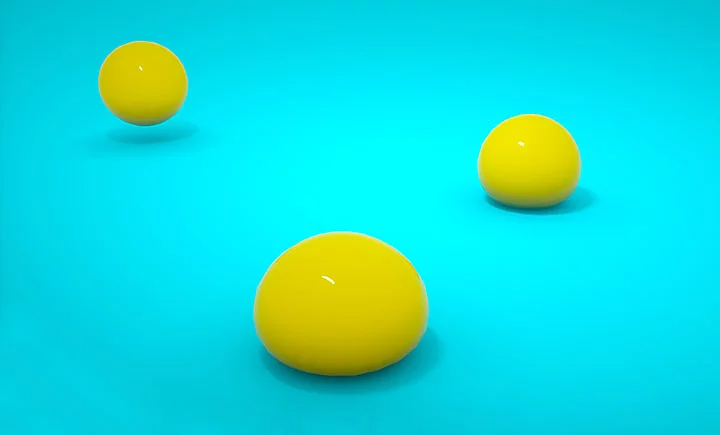
Cada una de las tres imágenes anteriores muestra la pelota en distintos estados. En conjunto, puedes imaginar con claridad que muestran un ciclo de la pelota al botar en la superficie.
Estas poses clave muestran las distintas expresiones y cambios de forma que toma la pelota al botar en el suelo. Sin ellas, podrías no darte cuenta de que la intención de la animación es mostrar una pelota botando.
- Sin la pelota de la izquierda, podrías pensar que la pelota es simplemente una mancha que tiembla en el suelo.
- Sin la pelota del centro, no se aprecia el efecto de la gravedad en la pelota al golpear el suelo.
- Sin la pelota de la derecha, nada registra la primera vez que la pelota golpea el suelo.
Los animadores precisan de poses clave para captar todo el rango de movimientos y expresiones que los objetos y los personajes tienen, antes de animar la secuencia completa.
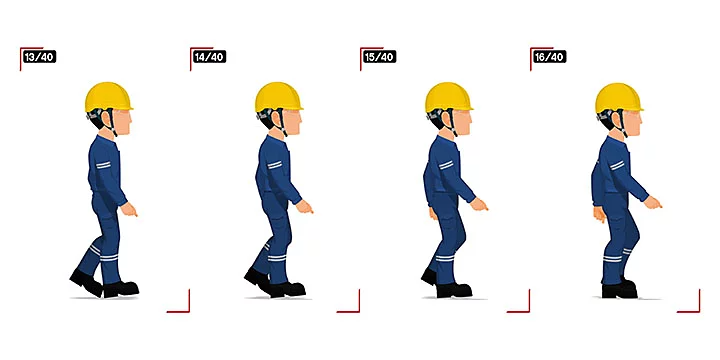
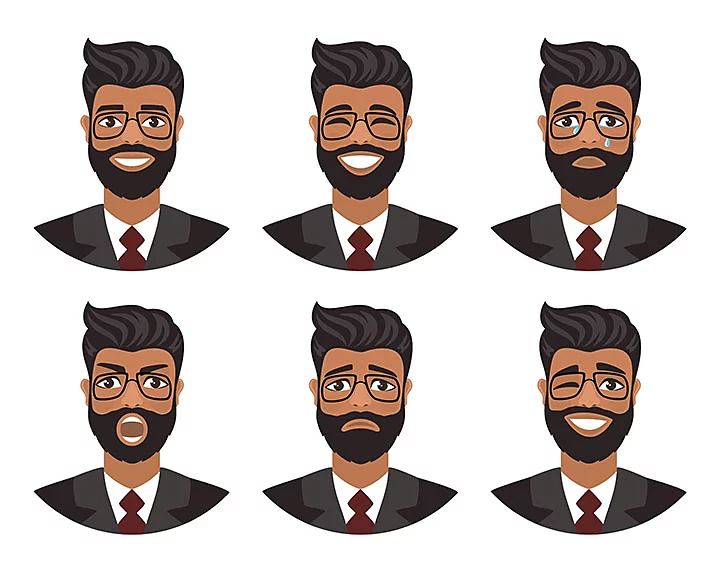
Una forma de movimiento más sutil, como la expresión facial de un personaje, también necesita una selección completa de poses clave. Un personaje que esté experimentando varias emociones distintas necesitará definiciones claras de cada una de ellas.
Si un personaje, como el hombre anterior, se siente agobiado por la decisión que tiene que tomar o está reaccionando a algo extraño, necesitarás una pose clave para mostrar cada fase de ese conflicto interno. De lo contrario, te arriesgas a no transmitir plenamente el impacto de sus sentimientos, lo que podría hacer que la historia resultara confusa.
La creación de poses clave es la mejor manera para garantizar la exploración total de los movimientos y las expresiones, antes de que los animadores prosigan con la animación de las secuencias entre medias.
Dicho esto, existe otro enfoque a la hora de animar que encaja mejor con un estilo experimental.
Cómo animar las poses.
Respecto a la animación con poses clave, hay dos enfoques opuestos: el primero se basa en ellas para componer la secuencia, mientras que el segundo se toma más libertades respecto a las poses iniciales. Vamos a ver qué diferencias hay entre ellos y cuál es el mejor momento para usarlos.
Animación con posturas y gestos.
En la animación pose a pose, se suele utilizar el proceso descrito anteriormente, en el que el animador tiene la tarea de crear las poses clave de la escena o los giros clave de la historia. Una vez que se han determinado las poses clave de la secuencia, el equipo se encarga de rellenar lo que falta con las interpolaciones. En los equipos grandes, podrían encargarse de esta tarea los animadores principiantes.
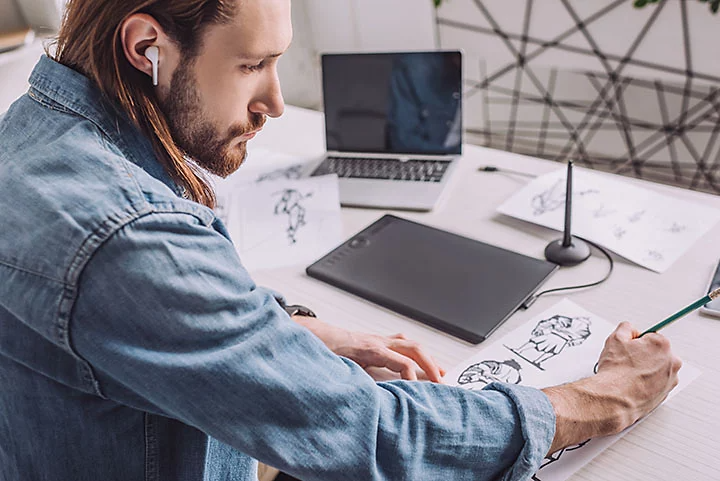
La animación pose a pose es más adecuada para las situaciones que requieren guiones gráficos más fluidos y estructurados. La cadencia es una parte esencial de este tipo de animación. Significa que los animadores pueden crear la cantidad de fotogramas necesarios para que las transiciones sean lo bastante fluidas. Al crear las poses clave de principio a fin, los animadores disponen de un mayor control del contenido de los movimientos intermedios (o interpolaciones) que componen la secuencia, tanto en términos de ritmo como de creatividad.
Los desgloses son una buena combinación de poses clave e intermedias, pues ayudan a desglosar la acción entre las poses clave A y B al añadir un paso más al montaje. En una secuencia que representa a un personaje que recorre andando la pantalla de izquierda a derecha:
- Las poses clave serían las del principio y el final de la secuencia, así como otras en los momentos en que los gestos, las expresiones o los pasos clave necesitan un énfasis adicional.
- Los movimientos intermedios son los fotogramas a cada lado de las poses clave, que completan los movimientos de forma fluida.
- Las interrupciones podrían ser los momentos en que el personaje se para a mirar el reloj o se tropieza un poco, es decir, cualquier cosa que interrumpa la secuencia y que le aporte espontaneidad.
Animación directa.
Al igual que en la animación pose a pose, la animación directa utiliza una pose clave como punto de partida de la secuencia. Sin embargo, a diferencia de la animación pose a pose, solamente se utiliza una pose clave inicial antes de que el animador se dedique a animar el resto de la secuencia, sin estabilizadores. No se utiliza la interpolación porque no hay más poses clave con las que sincronizar la acción.
La animación directa se adapta mejor a un estilo más experimental. Sin el arco proyectado de la animación pose a pose, las imágenes se van desarrollando con una interpretación mucho más flexible, aunque la secuencia parta de un guion. En la historia, algunos animadores prefieren utilizar la animación directa para representar secuencias libres que destaquen del flujo más estricto del resto del proyecto.
Woolie Reitherman, uno de los Nueve Ancianos de Walt Disney Productions durante las décadas de los 60 y los 70, afirma que la técnica le ayudó. “Cuando no sabía qué hacer en una acción, usaba la animación directa… Me resulta divertido. Descubres cosas que, si no, no se te habrían ocurrido”.1
La representación típica de una pelea entre dos personajes en pantalla, con una nube de puñetazos que se desplaza por el fondo de la escena, se expande y encoge a medida que progresa.
Hasta que acaba la pelea, y se muestra un claro vencedor (y perdedor), la nube de la pelea es un buen ejemplo de un evento directo que no necesita generar poses clave. Por ese motivo, su tamaño e incluso su color suelen variar a lo largo del proceso: sin las poses clave que respetar estructuralmente, la animación directa pierde coherencia a medida que progresa y puede cambiar de forma, de modo que parezca que es a voluntad.
¿Qué es mejor: la animación pose a pose o directa?
Ambas técnicas presentan sus ventajas e inconvenientes en términos tanto del proceso como del aspecto final.
Animación con posturas y gestos
Animación directa.
Poses clave: preguntas frecuentes.
¿Qué hay entre las poses?
Las poses intermedias son los fotogramas que se insertan entre las poses clave para que el movimiento de un objeto progrese desde el punto A al punto B. Aunque podrían parecer menos importantes que las poses clave, las poses intermedias constituyen la gran mayoría de la secuencia y se les concede menos consideración en el contexto porque no hacen avanzar la historia directamente.
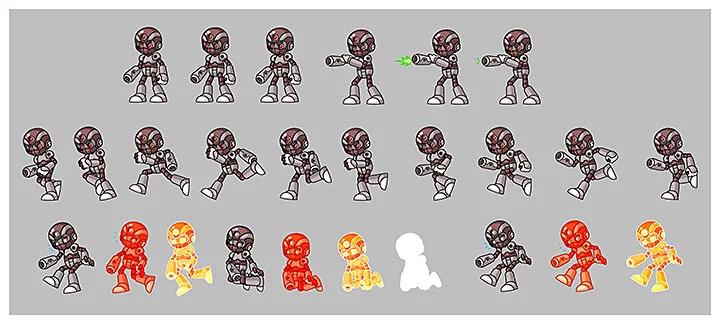
¿Qué es aplastar y estirar en animación?
Aplastar y estirar es una técnica que se utiliza para aportar flexibilidad natural y reducir la rigidez en el movimiento. Se hace para exagerar una forma y hacer que parezca más caricaturizada sin salirse de los límites realistas. Un personaje que se agacha para saltar podría aplastarse y estirarse más de lo que lo haría un ser humano al saltar en la realidad, pero el efecto aporta fluidez y dinamismo al movimiento.
¿Cuáles son los 12 principios de la animación?
Este término lo acuñaron Johnston y Thomas al estudiar la historia de la animación de Disney en un libro publicado en 1981. En este libro se resume este filón de obras en 12 principios subyacentes (incluidas la animación pose a pose frente a la directa) y se explican los aspectos más interesantes de cada uno de ellos.